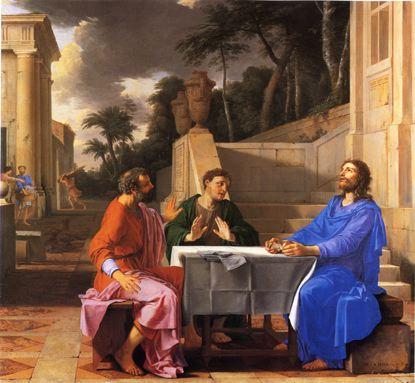-
Table of Contents
- 0. STORY PREFACE
- 1. THE DEATH OF LAZARUS
- 2. TRIUMPH IN JERUSALEM
- 3. JESUS PREDICTS HIS DEATH
- 4. THE LAST SUPPER
- 5. THE GARDEN OF GETHSEMANE
- 6. THE ARREST
- 7. THE FIRST TRIAL
- 8. THE SECOND TRIAL: BEFORE PILATE
- 9. JESUS BEFORE HEROD
- 10. THE DEATH SENTENCE
- 11. THE CROSS
- 12. THE PLACE OF THE SKULL
- 13. THE TOMB
- 14. AN EMPTY TOMB
- 15. JESUS APPEARS TO OTHERS
- 16. EASTER STORY in ART
In 1656, Laurent de la Hyre (1606-1656) created this oil-on-canvas painting (now maintained at the Museum of Grenoble) entitled Apparition du Christ aux pélerins d'Emmaüs ("Appearance of Christ to the pilgrims of Emmaus"). Image online, courtesy Wikimedia Commons.
The New Testament records that Jesus appeared to His disciples several times after his resurrection. He also joined two men walking along the road that leads to the village of Emmaus, about seven miles from Jerusalem. He ate supper with them later in the day.
Some of the people closest to Jesus doubted He was really alive. After all, they had watched Him die. How could he possibly be alive?
Some of the doubters (like Thomas) saw Jesus again:
They were startled and frightened, thinking they had seen a ghost. He said to them, "Why are you troubled, and why do doubts rise in your minds? Look at my hands and my feet. It is I myself! Touch me and see; a ghost does not have flesh and bones, as you see I have."
Then, one night, Peter and six other disciples decided to go fishing in the Sea of Galilee. After a long evening of no results, they saw a man on the shore who asked whether they had caught anything.
Learning it had been a fruitless effort, the stranger suggested they throw the net on the right side of the boat. One hundred and fifty-three fish later, the men realized the figure on the shore was Jesus.
Not long after the fishing episode, Jesus and his disciples walked toward Bethany - the village of Mary, Martha and Lazarus. Something unusual happened while Jesus, with raised hands, was blessing his friends:
When he had led them out to the vicinity of Bethany, he lifted up his hands and blessed them. While he was blessing them, he left them and was taken up into heaven.
Christians call that event the ascension.
-
Table of Contents
- 0. STORY PREFACE
- 1. THE DEATH OF LAZARUS
- 2. TRIUMPH IN JERUSALEM
- 3. JESUS PREDICTS HIS DEATH
- 4. THE LAST SUPPER
- 5. THE GARDEN OF GETHSEMANE
- 6. THE ARREST
- 7. THE FIRST TRIAL
- 8. THE SECOND TRIAL: BEFORE PILATE
- 9. JESUS BEFORE HEROD
- 10. THE DEATH SENTENCE
- 11. THE CROSS
- 12. THE PLACE OF THE SKULL
- 13. THE TOMB
- 14. AN EMPTY TOMB
- 15. JESUS APPEARS TO OTHERS
- 16. EASTER STORY in ART


 Back
Back
 Next Chapter
Next Chapter

 Back
Back
 Next Chapter
Next Chapter
